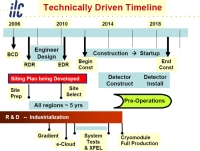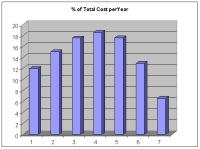Director's Corner
14 June 2007
 Barry Barish |
A technically driven timeline for the ILC
Last week, I made a presentation at Fermilab’s 40th Annual Users Meeting where I focused on the GDE’s technically driven timeline for the ILC. Following Ray Orbach’s statement that the ILC completion will likely be delayed until 2025 or later, Fermilab has undertaken a study to develop a strategic plan for the laboratory that takes into account a possible stretched out schedule for the ILC. Young-Kee Kim, deputy director of Fermilab, is leading the study with a goal of producing recommendations later this summer. In the context of this study, I decided it was important for me to lay out the basis of our GDE project timeline.
We do not have a true project “schedule” at this time and won't have one until we complete the ILC engineering design in 2010. Nevertheless, we have studied the critical path for the project and as a result put together what we believe are the main elements of a technically driven “timeline.”
What do we mean by a technically driven timeline? Our timeline is based on our best assessment of what could be done if only technical considerations are taken into account. We have used a combination of the ILC Reference Design, our R&D plan and our EDR plan to make our estimates. This is a very important planning tool internally, as we will be developing the engineering design towards this baseline timeline.
The first top-level milestone in our timeline is production of an engineering design and report (EDR) in 2010. The Reference Design Report (RDR) we recently completed is a self-consistent concept, one we were able to cost and one that will give us a solid platform from which we will develop the engineering design and supporting R&D. Nevertheless, the reference design does not define an ILC that we would want to build.
We expect the design to undergo considerable evolution in the next phase to optimise performance to cost, minimise technical risks, match resources and industrialise. R&D will continue after the EDR is complete so that the evolution of the design will continue until we actually build the ILC. The projected resources appear sufficient for us to achieve the first milestone, provided we bring on sufficient project strength and establish priorities for our R&D programme. For example, we must demonstrate the accelerating gradient as well as test schemes for mitigating electron cloud effects before we can complete the engineering design.
The second major milestone in our timeline is to initiate the project start in 2012. The host country will begin to make major investments in site and facility development at this point, and we will need to commit resources for long lead items like the 14 thousand cavities. We also will need to support systems tests that will be needed to reduce the risks in the large scale production of main linac components. We are not yet able to make a good bottoms-up estimate of project resources needed for the first year, but we have estimated that upwards of 10% of total project costs will be needed.
The last date on our timeline is project completion in 2019. This date reflects the seven-year construction period that we used for the reference design. We still need to do a parametric study to assess the cost and technical risks for different construction periods, but an initial study indicates we might save 10% on the civil costs for an eight-year construction period. The primary ingredients in construction will be the civil and facilities construction that will take 4 to 5 years, followed by accelerator and detector installation and testing. The general scheme includes building and commissioning the central injectors early and assembling the detectors in large systems on the surface, before lowering them into the experimental halls.
Our technically driven timeline is admittedly our first attempt toward a project schedule, but is already realistic enough to help us identify the key milestones and considerations in achieving our timeline. For example, we are in the process of defining the pre-construction work that must be achieved for candidate sites, in advance of site selection. We have determined the early decisions that will be required for completing the design and the RF cryomodule systems tests we will need to sufficiently reduce risk before mass production.
Other crucial factors, like project approval and funding, international agreements and governance and siting must be accomplished before the ILC becomes a reality. These factors may or may not significantly lengthen our schedule. The key will be minimising these effects by working these issues in parallel with the design and R&D effort, and that is exactly what we intend to do.
-- Barry Barish

